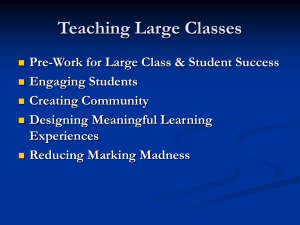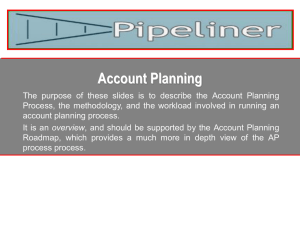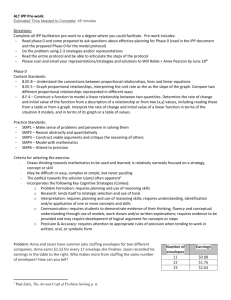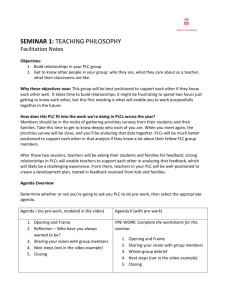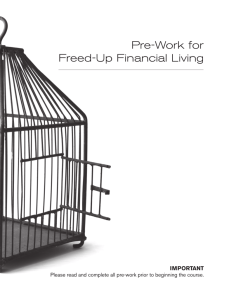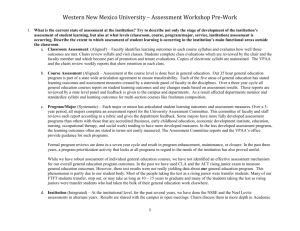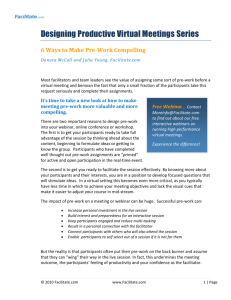Account planning roadmap - Pipeliner
advertisement
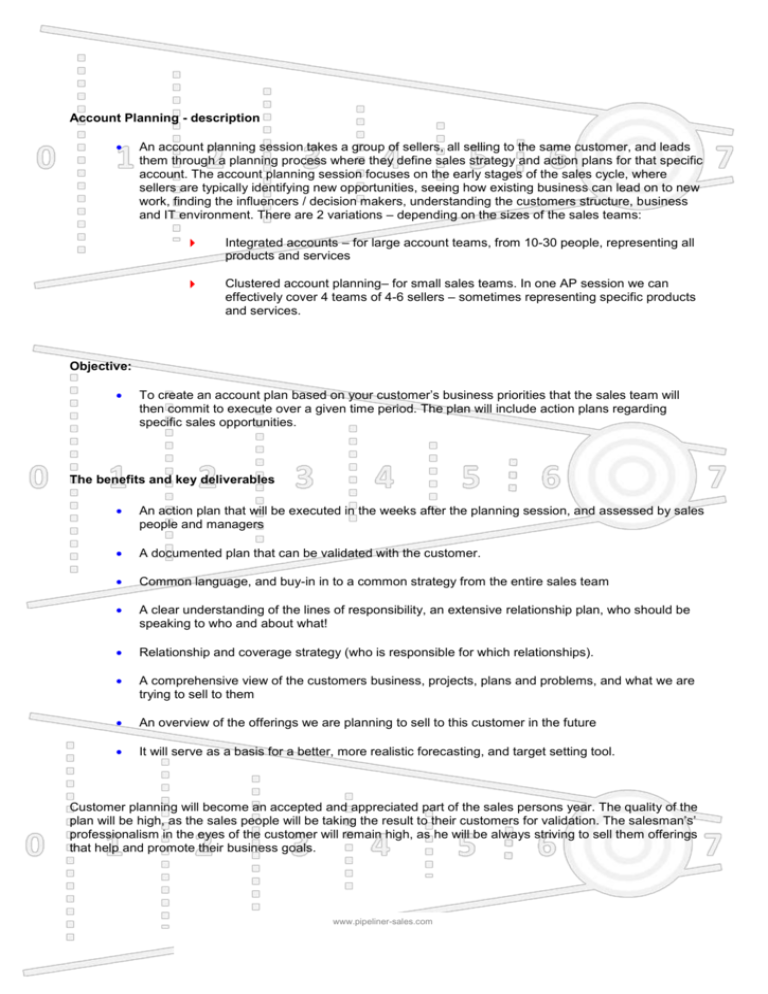
Account Planning - description An account planning session takes a group of sellers, all selling to the same customer, and leads them through a planning process where they define sales strategy and action plans for that specific account. The account planning session focuses on the early stages of the sales cycle, where sellers are typically identifying new opportunities, seeing how existing business can lead on to new work, finding the influencers / decision makers, understanding the customers structure, business and IT environment. There are 2 variations – depending on the sizes of the sales teams: Integrated accounts – for large account teams, from 10-30 people, representing all products and services Clustered account planning– for small sales teams. In one AP session we can effectively cover 4 teams of 4-6 sellers – sometimes representing specific products and services. Objective: To create an account plan based on your customer’s business priorities that the sales team will then commit to execute over a given time period. The plan will include action plans regarding specific sales opportunities. The benefits and key deliverables An action plan that will be executed in the weeks after the planning session, and assessed by sales people and managers A documented plan that can be validated with the customer. Common language, and buy-in in to a common strategy from the entire sales team A clear understanding of the lines of responsibility, an extensive relationship plan, who should be speaking to who and about what! Relationship and coverage strategy (who is responsible for which relationships). A comprehensive view of the customers business, projects, plans and problems, and what we are trying to sell to them An overview of the offerings we are planning to sell to this customer in the future It will serve as a basis for a better, more realistic forecasting, and target setting tool. Customer planning will become an accepted and appreciated part of the sales persons year. The quality of the plan will be high, as the sales people will be taking the result to their customers for validation. The salesman’s’ professionalism in the eyes of the customer will remain high, as he will be always striving to sell them offerings that help and promote their business goals. www.pipeliner-sales.com Methodology: 1. Industry analysis of current trends and environment. (OP Opportunity Plan) 2. Analyse customer’s business environment. (OP Opportunity Plan) 3. Analyse customer’s IT environment. (TSL Total Solution Landscape) 4. Analyse relationship and coverage strategy. (PPM Pain and Personality Map) 5. Assess and prioritise current opportunity list. (OL Opportunity List) 6. Develop customer validation plan. (Action Plan) these activities will be executed during the pre-work stage, the facilitated account planning session, and afterwards with the customer. Account Planning – critical success factors: Completion and validation (with the customer) of pre-work before the session. Management commitment and leadership in all stages of the account planning process. Team members sharing customer knowledge. Customer experts – whether they are from the immediate team or not – sharing and adding value to the session. Commitment to execute the plan. Compelling reasons to do an account planning session: Management requires formalised, structured, concrete account plans that enable them to make a variety of headcount, coverage and management decisions. The sales team is in danger of not making for the current of next quarter. (Unfortunately, we cannot guarantee quota!). The sales team (or the customer executive) wants to plan the following year’s activities and hold everybody accountable to the plan. A meaningful way to spend a sales meeting. www.pipeliner-sales.com Roadmap. The following plan can be used by sales managers to organize and facilitate an account planning session: The account planning process works in 3 stages: Stage 1 Stage 2 Stage 3 Pre-work Account Planning workshop Execution and follow-up 6 weeks 1-2 days Ongoing Stage 1 Pre-work 6 weeks The facilitators begin a process of communicating with the Client Executive (Key Account Manager – or the person with overall responsibility for the customer) and the sales team, and verbally explaining the objectives of the session, and how to complete the pre-work document. Each sales person contributes to the pre-work document from their own perspective, and the facilitators merge all the work into 1 master plan, that is then used as the foundation for discussion in stage 2. The pre-work document is tested for quality and clarity in a series of individual calls and/or conference calls with the Client Executive and sales team. The first calls will also contain short tutorials that explain the concepts in the plan (although the concepts are straightforward and do not need much explanation) The contents of the pre-work document are as follows: Section 1 Customer’s Business Initiatives Section 2 Customer’s Business Drivers / Business Initiative Interlock Section 3 Opportunity List Section 4 Business Initiative / Opportunity Interlock Section 5 Pain & Personality map Section 6 Enterprise Action Plan Understand the customer projects, plans and initiatives – not only technology, Get a good understanding of the customers’ business. Understand the problems in the customer’s market and industry that are forcing them to change, and to react. Link these to the Business Initiatives. Create a complete list of all the opportunities the team is aware of, and search for new opportunities. Understand the potential value of the customer. Are we selling to opportunities that are supported by the customer’s business plans? Who are the people with have relationships with, where do you want to build relationship? Who is speaking to who? Who will do what and when? Specific actions designed to move opportunities forward, build further relationships, open doors, cross sell, up-sell etc. www.pipeliner-sales.com Stage 2 Account Planning workshop 1-2 days During the 2 day facilitated customer planning session, the team works through the pre-work document, speaking about opportunities and defining actions. Below is a list of the subjects covered over the 2 days. For all the points listed below, actions, with owners and due dates are collected and recorded in the Enterprise Action Plan (Section 6 of the pre-work document). Day 1 Client executive gives a top-level presentation about the customer. (In some cases, a sponsor from the customer may also be invited to give this presentation) Understand the customers business drivers, and business plans for the next 12-18 months Understand the opportunity list Understand which opportunities are supported by which business drivers and plans, and prioritize among the opportunities Identify new opportunities Understand the relationship & coverage plan Plan specific opportunities Complete and get commitment to the action plan Discuss next steps Discuss how to communicate the results of the Account Planning session to the customer Day 2 Stage 3 Execution and follow-up Ongoing After the 2 day session, the pre-work document, which is now the completed customer plan, gets put into action. The SCE tracks the actions and the results of the actions The sales people take certain parts of the plan to the customer for validation, and use the knowledge generated to create more opportunities and sell better to existing opportunities The responsibilities of the Client Executive, and the sales team Stage 1 – pre-work phase www.pipeliner-sales.com Setting the dates for the customer planning session Choosing and inviting the team Communicating the objectives of the Customer Planning Process to all invited team members and all non-invited team members who need to be in the loop Decide whether to involve the customer in some capacity (usually in the morning of the 1st day for the official customer view) Work with the facilitators to fine tune the objectives of the session, and prepare official inputs and presentations Organizing logistics (hotel / seminar facilities) and securing a residential event (this session works best when people can stay overnight) Contributing their perspective to the pre-work document Communicating the Customer Planning Process to high level customer execs Stage 2 – customer planning session Motivating and setting the scene for the team. Opening statement. Presenting the official view of the customer Adding input as and when necessary Delegating tasks to sellers present or absent if necessary Working with the facilitators to fine tune the flow of the session Closing remarks. Stage 3 – execution and follow-up Creating and owning the finalized version of the customer plan Deciding which pieces of the plan may NOT be shared with the customer, and editing a version that CAN be shared with the customer Distributing the finalized plan to the sales team and other interested parties Tracking the action plan and running follow-up sessions (one 2 one or group discussions with sellers) Measuring the success of the Customer Planning Process Entering relevant data into CRM system (potential opportunity values) The responsibilities of the sales team in Stage 1 – pre-work phase Committing to the dates for the customer planning session Assessing the list of participants and communicating if they want other people involved www.pipeliner-sales.com Work with the facilitators to understand the pre-work Contributing their perspective to the pre-work document and in the best case, validating some of this information with the customer prior to the workshop Communicating the Customer Planning Process to their customers and setting the stage for the follow-up actions Evaluating the pre-work document as it grows The responsibilities of the sales team in Stage 2 – customer planning session Adding input where necessary Challenging assumptions, making suggestions, searching for growth potential Taking responsibility for actions entered into the action plan Being proactive Promoting activities that use the whole TE spectrum of products and services Stage 3 – execution and follow-up Taking the relevant parts of the plan to the customer and using it to sell more, create new relationships, and generally get the customers perspective on the plan Execute the action plan Communicate with the SCE and the rest of the team as and when necessary Inviting the right people In theory, this should be any sales rep who has existing relationship and opportunities in the customer organisation, and who has a good knowledge of the customers business. In fact, the easiest way is to invite ALL the sales reps who sell to this account. Here are some role definitions of people who will add value. (The numbers below are to show proportion – not exact numbers. However, this session is dictated by the people who NEED to be there, rather than a limit. Try not to go over 26 people) (3-15) Sales reps. People with a hunter pro-active attitude. (1-3) Politicals. High level people, who have high level contacts and can get meetings with important customer execs if necessary. (Account managers, client executives, general managers) (2-3) Consultants / project managers /SMEs. People who have worked with the customer in key projects, and who have large networks of relationship within the customer’s organisation, but do not need to be sales people. (SMEs are Subject Matter Experts, with specific industry knowledge of the customer) (1-2) techies who have low level contacts with the customer on a project basis www.pipeliner-sales.com
